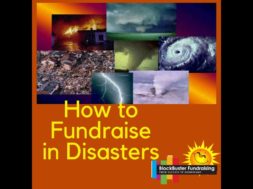Facing Disaster! How to Fundraise in Disastrous Times
Faced with over a month of terrible disasters in 2017, only weeks from year-end fundraising, how do we proceed to raise money for our causes without seeming insensitive to the horrendous circumstances facing so many?
– Hi, Joy Olson here of Blockbuster Fundraising. You know, this year of 2017, the entire month of September and early October we have faced of so many horrific disasters.I mean, it started out with Hurricane Harvey, Irma.We’ve had earthquakes, Puerto Rico, outrageous fires in Pacifici Northwest and now it seems California is burning down.Many fundraising experts pose the question, can we fund raise $$$ in the face of these disasters?And how do we do that?
I thought that today,I would take a compilationof some of those different articles, blogs that I’ve read and pcombine the advice for us.When I first reported on this way back with Hurricane Harvey, I really talked a lot about and reviwed The Agitator and that blog was saying. I thought that it was really relevant.
Now today, like I said it’s gonna be a compilation.
I’m want to start with Marc Pitman,who certainly is no stranger to people who follow fundraising experts. Marc talked about two different ways to respond to a tragedy such as the devastationthat people are experiencing with the hurricanes and fires.
And he shares this with us,and I think that you will appreciate it.
He says that disasters like this pull on our heartstrings and pull on the heartstrings of our donors ( I don’t know about you but I am in tears watching the news these past weeks!). We all make donations to support those affected.I certainly have and I know you have too and you just feel like
you can’t do enough.
And if your nonprofit isn’t in an affected area,disasters like this can make it challenging to think about fundraising for your own institution because you just feel like there’s so many people that are just facing such massive devastation that you should be helping them instead of your own mission.
Well, Marc Pitman says that having worked in nonprofits through many disasters, whether they’re weather,economic or even terrorists, he says I’ve had to help nonprofit leaders figure out how to reconcile their desire to keep with their need to fund their own organization.And he says he’ll share two
different approaches to us in the wake of this kind of the disaster.
He says, as nonprofit leaders and fundraising professionals if we live outside the affected areas or outside nonprofits providing assistance, these two approaches can help us.
He says one thing you can do is just simply pause your fundraising. Marc Pitman says that he thinks this is the most common response he’s seen, and he says that it simply seems sometimes the right thing to do. It seems respectful and considerate.
But the one big mistake he says that people make with this approach is to equate,”pausing fundraising,” with ceasing all communications. And he says don’t do that.
You should definitely check your upcoming communications and social media post to see if they’ll appear tone deaf to your audience, but do not stop talking
to your supporters. Your cause is still worthy of philanthropic support.
The need that you exist to fix isn’t going away, so neither should you!
And pausing your solicitations right now, you may choose to devote your major gift calls to expressing your gratitude.
Good plan. Call donors and say thank you. You may even consider sending a postcard to supporters, thanking them for their
support of your mission and encouraging them to support one of the groups your own organization is making donations to.
Hitting the pause button, Marc Pitman says, can be a reasonable approach to fundraising in the wake of disasters.
Second thing you can do is fundraise carefully. If your organization still needs funds that you were planning on soliciting right now or this week perhaps you
had a direct mail going out, you still need to get out there and raise those necessary monies.
But this week, as you make your major gift contacts, listen, he says, with your heart even more than you normally do. Even if you’re far from Texas, Florida, Puerto Rico or California, a lot of your donors may have family that’s really have been devastated or are hurting from hearing so many tragic stories that have been experienced by their own friends or family, or they’re just feeling terribly sad and depressed at the news.
Most people are devastated by the news right now. So you wanna repect and hold that emotional space with your donor. Be a safe person to help
them start processing their grief, their worry, their anguish.
Marc Pitman says, be human, be full of care. And still ask.
If you’ve got to ask, you’ve got to ask. If this was your plan and your mission is counting on these monies right now, you might modify your ask amount,
but your cause is worthy of the funding!
And finally, Marc Pitman suggests a third way to fundraise in a disaster situation that we face this SOctobe of 2017. He says the third way is to do both.Both pause with some prospects and ask carefully with others. He says it’s times like these that we get to see the best in each other. And hasn’t that been true? Don’t you love these “heroes revealed’ news reports that we’ve seen, people just going to the ends of the earth to help one another? And as nonprofit leaders and fundraisers, we get a front row seat to that beauty and generosity.
So that is what Marc Pitman has to say about disaster fundraising.
Now let’s take a look at another expert. Another great disaster fundraising article was written by Gail Perry,and I think it’s really quite terrific.
And so I’d like to refer to it right now.
Gail talks about disaster fundraising and what you need to do. And first of all, she says you need to respond carefully. Carefully.
Communications with donors need to be precise and convey the correct tone. You can’t be cavalier about disasters like this, it’s affecting amillions of people,even if your organization is not involved in a disaster response. A lot of your donors have friends and family that are really affected by
what’s going on right now.
So Gail Perry asks the question, how should your nonprofit respond when natural disasters, wars or crisis strike? And here is Gail Perry’s suggestions and advice.
If you are not engaged in a disaster response mission, do these three things.
One, tell your donors how you are trying to help out. If a disaster is on everyone’s minds, your donors will want to know that you are mobilizing somehow, someway. For examle, if you’re a humane society and the hurricanes and fires have dislodged all kinds of pets from their homes and ownerssee how you can help. Humane societies in Texas or Florida can’t keep the animals that they’ve got, then possibly you can step in and help out and bring animals into
your humane society.
And you want to let your donors know that you have mobilized and you are helping in some way if you are. And your donors are gonna wanna know how you’re pitching in to help the situation.
Okay, number two, recommend some places for your donors to give. And Gail says yeah, that can be really awkward. But if your donors are
concerned and even obsessed with the situation, it’s perfectly appropriate to recommend trusted
nonprofits for contributions. Certainly you can discuss this with your executive director
and your board members and come up with some trusted opportunities to help.
And third, Gail Perry says, is delay soliciting your donors for your own cause. She says she’d recommend stepping back and waiting for a few weeks. And it seems like every single week we have a new disaster lately.My goodness.
So for those of you that were planning a big fall letter or a fall early October fundraising campaign, this has certainly put a poignant pause in your plans. So Gail says that it would really seem self-serving or even tone deaf if you send out a passionate appeal for your own work while your donors are so concerned about the hurricanes and fires and shooting rampage.Timing is everything, but any communication that refers to the disasters, she says, needs to be very soon after the event. If you wait a few weeks, she says it may seem awkward and ill timed and the disasters will no longer be top of your mind with donors.
Well, that’s a little bit difficult lately because it seems like, as we mentioned before, every week, there’s been a new disaster.
So you have the choice now staying silent or showing up after the events as helpful and concerned.
Okay, that’s if you are not engaged in responding to a disaster mission. But what about if you’re one of the nonprofits that are engaged in responding to a disaster? Well, Gail says, and I’m sure you’ve done this and did do this, is connect with your donors immediately, right now, share the facts immediately
with your donors. Your donors wanna know exactly what’s going on, and they wanna knowwhat your program people are seeing out there in the disaster areas, and you want to give them as many specifics as you can, of people impacted, the extent of the damage, et cetera.
Watch video for more













